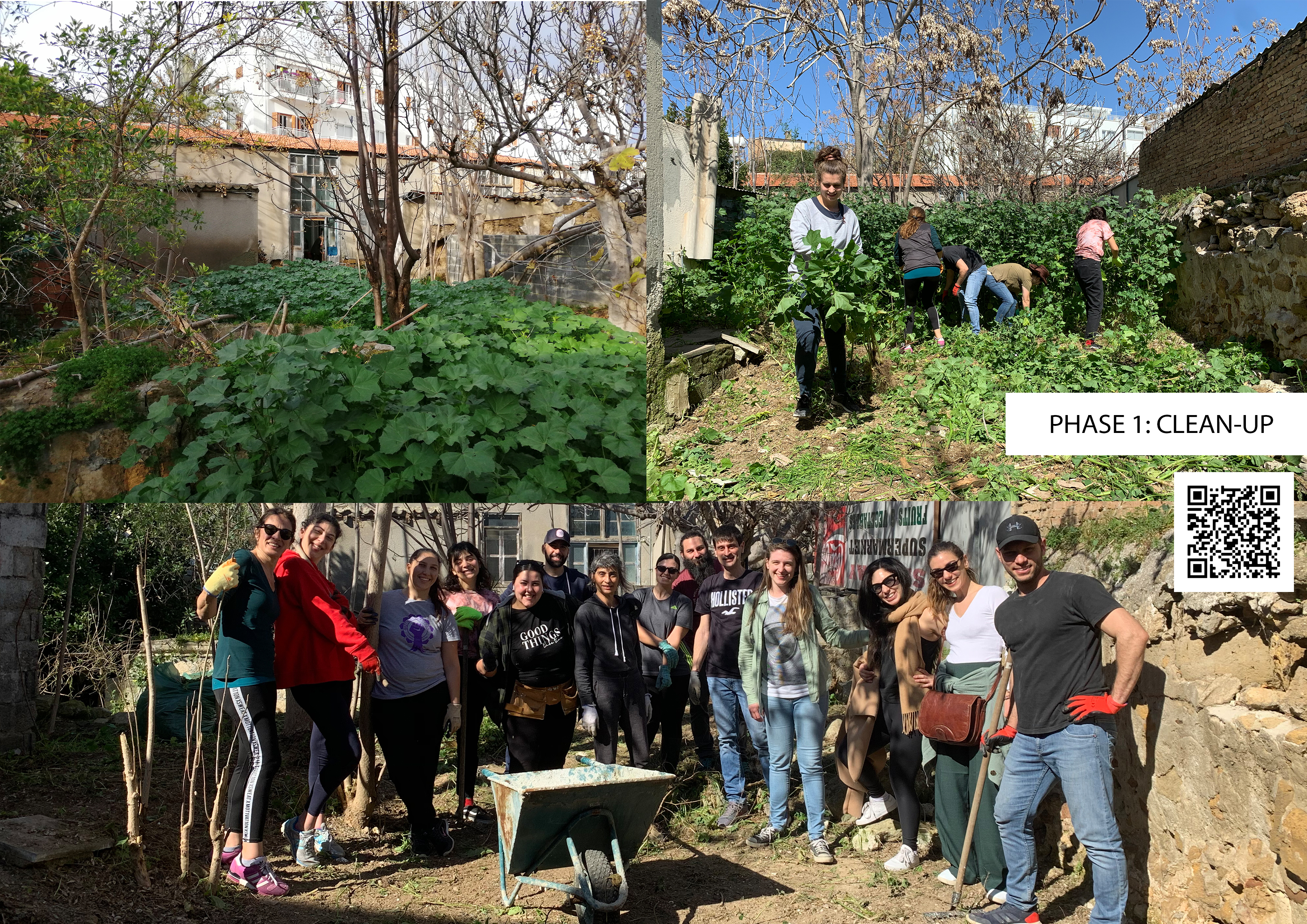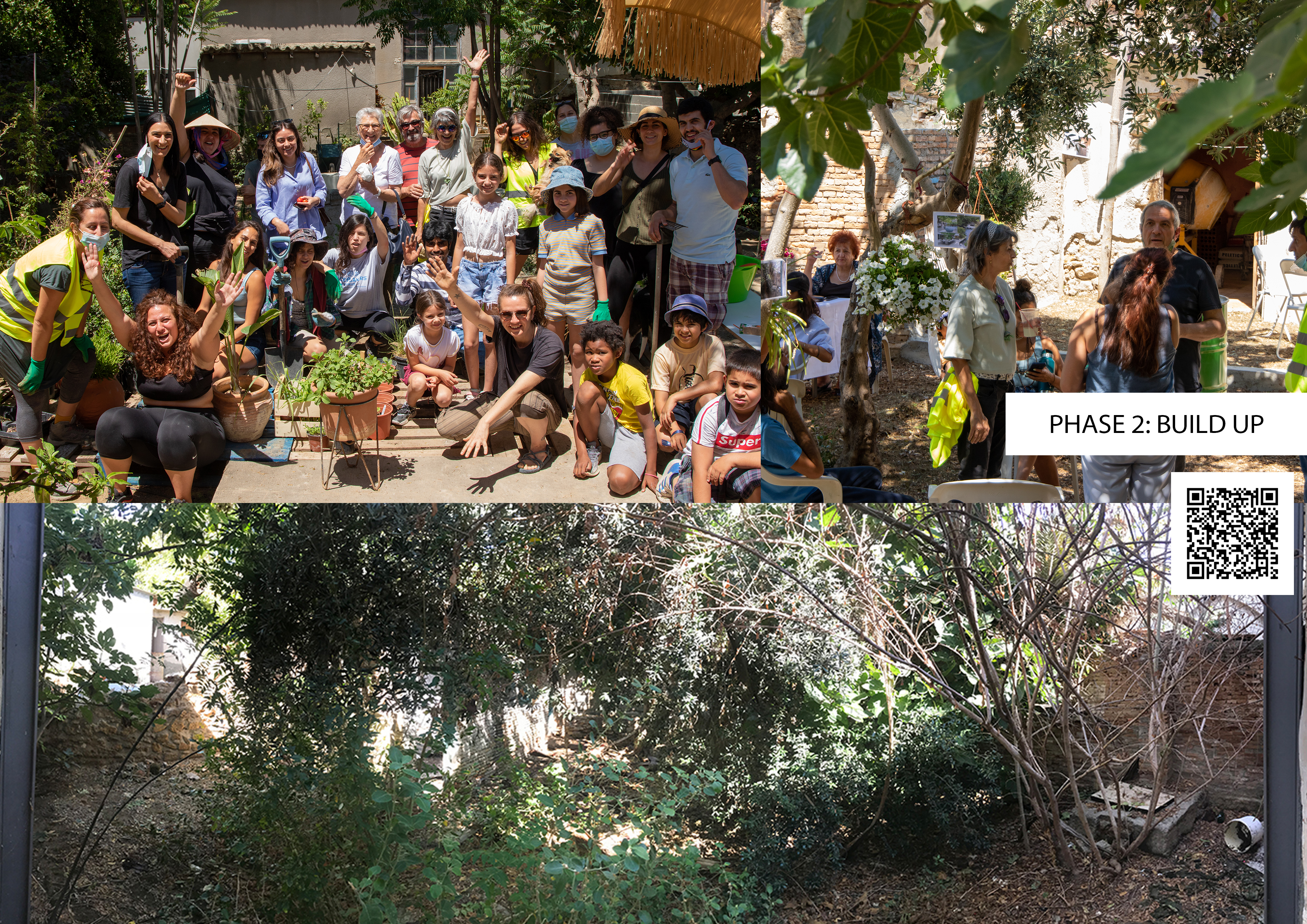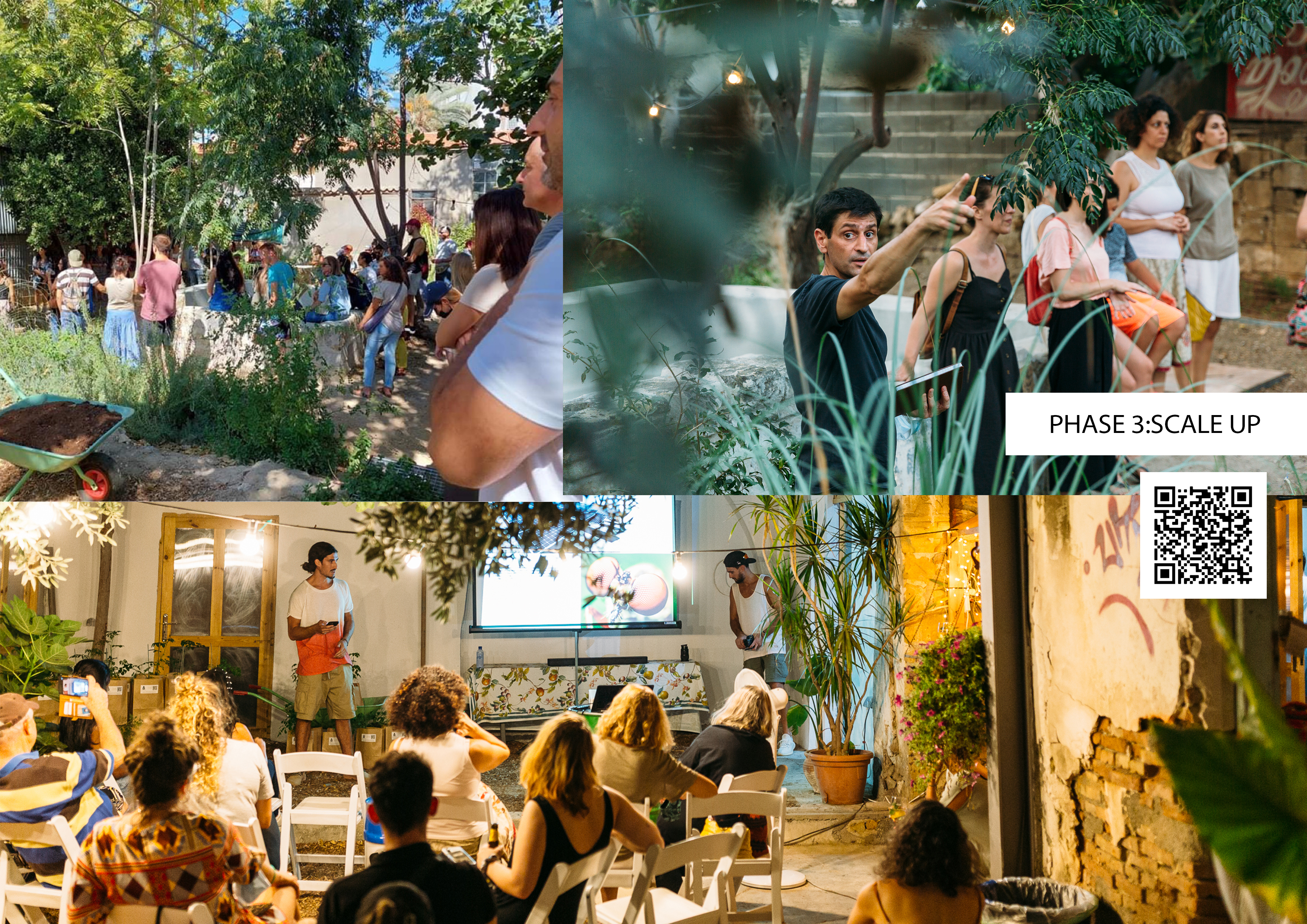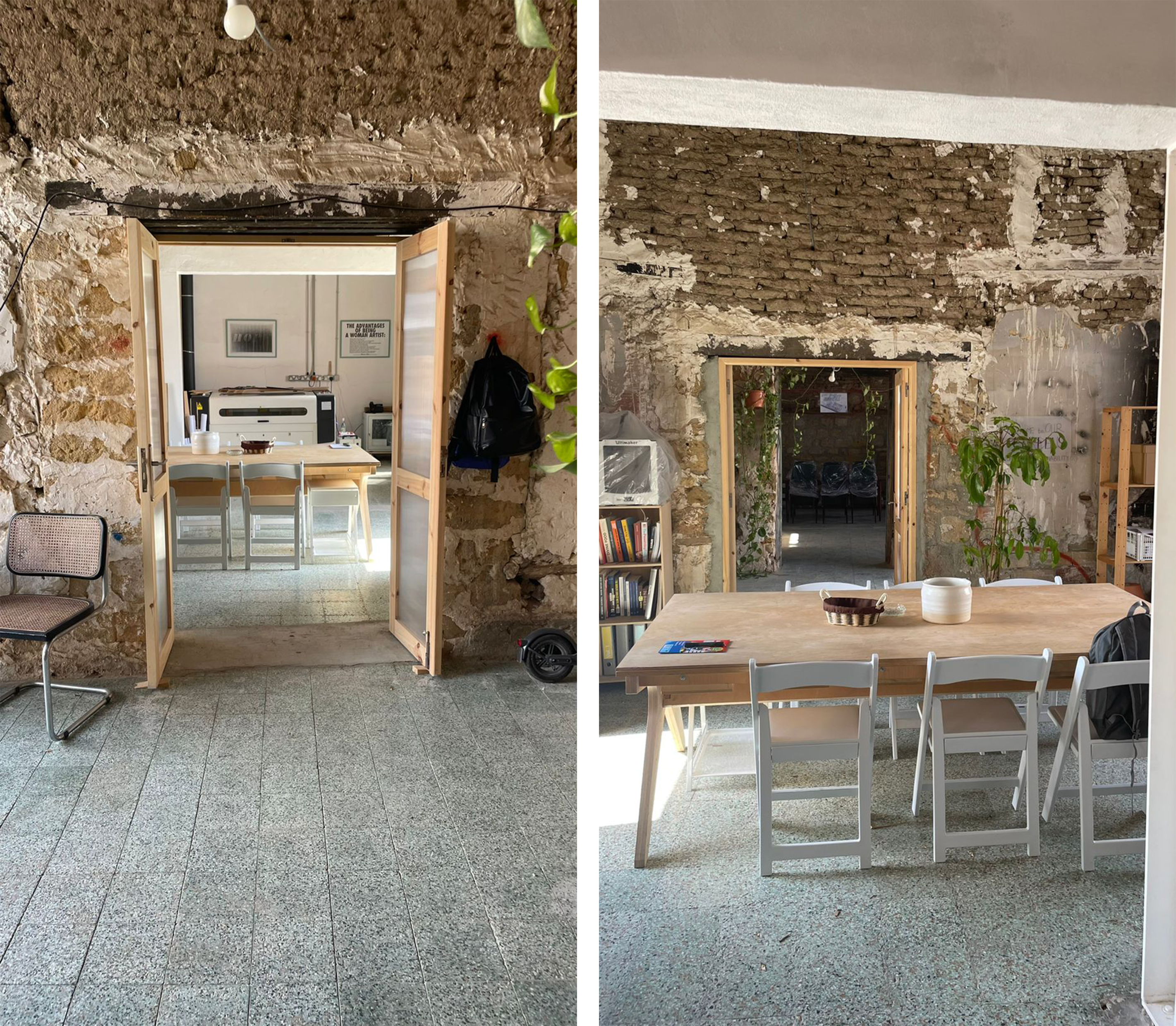Gardens of the Future is a grassroots organisation transforming an abandoned area in Cyprus’ politically divided capital Nicosia, into a community garden. The aim is to revive people’s sense of belonging and connection, in the process of bringing a no man’s land back to life. Gardens of the future is the leader of a growing network to develop sustainable change elsewhere in Cyprus, while preserving its unique cultural, social and environmental identities and values.
n the prospect of how citizens in action may tackle some of the most pressing issues relating to society and the environment, this is where our story begins. Gardens of the Future located in Nicosia, Cyprus, has brought people and organisations together in an effort to achieve one shared vision: to positively impact the lives of others by 2030 through co-creation.
During the implementation year, while utilising community-led development, along with the support of governmental institutions and other enterprises, the project intended to transform an abandoned area in the heart of the city (total area of 1000 sq.m. standing still since the 1974 political division) into an ‘alive’ space of human connection and belonging.
Key objectives of the space are:
•to be transformative and offer pioneered possibilities around the matters of zero waste and circular economy, to become an ambassador of sustainable practices and accommodate agro-entrepreneurship training;
•to be collective and inclusive by using the actual garden area as a vehicle to blend different local communities together, traditionally kept apart, regardless of age, gender, religion and ethnic backgrounds to empower, exchange, experiment, and achieve well-being;
•to be empowering and educative and generate scalable impact by ‘growing’ satellite gardens in other areas and create a network of places of belonging and sustainability.
During our operations we demonstrated a strong public and social media engagement, and we’ve been honoured to be featured at a national level as a “role model of the future” on matters of sustainability, zero waste practices, and inclusion.
Despite the ongoing pandemic, many exciting things are planned for 2022, hosting more open educational activities for the community and experimenting on new prototype modules.
Please highlight how the project can be exemplary in this context
The key objectives include the generation of impact across:
#Sustainable Development: The space of the Garden is completed to the level of being able to be welcoming for hosting any type of activity towards well-being.
#Circular Economy: A big part of the strategic planning was dedicated to the research & development of Garden Modules to be constructed using a ‘building from waste’ philosophy.
#Enable Locals Become Agro-entrepreneurs: Continued and sustained impact over time and especially in supporting others in developing green and social entrepreneurship endeavours.
#Scalable Impact: The Gardens of the Future modules are designed to scale and replicate. Currently consulting interested parties in responsible food production and zero-waste management.
Key highlights that have contributed to this impact, include but are not limited to:
●National Finalist and International Winner of the Global Climathon Competition
●Achievement of top 5 ranking in the CASSINI Space Entrepreneurship Initiative hackathon by the European Commission
●Frequent gardening initiatives such as seed weeks, planting weeks, clean-ups, and more, engaging the local community with a hands-on experience with their environment
●The launch of our first satellite garden in the Buffer Zone involving a clean-up event
●The launch of our first harvest boxes, which were distributed to the community and packed with fresh vegetables, plants, dried herbs, and educational materials
●Hosted and helped organise the Urban Entrepreneurship Summer Course organised by the University of Cyprus where students had the opportunity to address urban challenges, understand social entrepreneurship, and develop their business ideas.
Please highlight how the project can be exemplary in this context
Gardens of the Future design approach: The spatial elements of the garden have been developed in collaboration with experts (i.e. designers, local makers and researchers) and the community (end-users, students, other volunteers, etc.). Experimental testing is embraced for integration and showcasing at the gardens’ space (new outdoor floor, water system, smart bench, and more).
#Human-Centric Approach: A deep understanding of the different needs of multiple stakeholders and complex existing funding procedures is required. Design Thinking, as a process for creative problem solving that follows a human-centric approach was applied as a way to evaluate the current issues and therefore identify the ‘ what’ and ‘how’ towards the solution (s). Gardens of the Future methodology is based on design-thinking.
#Design Experimentation: The spatial elements of the garden have been curated through interdisciplinary collaborations with relevant experts (i.e. designers, local makers and researchers). Experimental testing is embraced for integration and showcasing at the gardens’ space (new outdoor floor, water system, smart bench, and more).
Key highlights that have contributed to this impact include:
●Served as an official city stop on the Sustainable Nicosia Walking Tours organised by the Home For Cooperation and the Association for Historical Dialogue & Research
●Invited in Cyprus Talks Green, an event jointly organised by organisations across Cyprus which promote sustainable practices and is part of #EUGreenWeek 2021 events
● Provided welcoming tours and inspiration to 2000+ visitors since its inception. Friends of the Gardens are interested in employing elements of the Gardens within their communities.
Please highlight how the project can be exemplary in this context
The key objectives include the generation of impact across:
#Inclusiveness in the City: A diverse audience visitors, volunteers, collaborators and others seeking to find inspiration and motivation have been engaged actively at the Gardens of the Future. The space is providing the necessary environment to allow everyone to feel at ‘home’. Different social groups include: students, entrepreneurs, professors, government officials, homeless individuals, refugees, journalists, spirituals and activists from diverse nationalities gather for our activations.
#Inspire National Action: During the community-led development journey, along with the support of governmental institutions and other enterprises Gardens of the Future manages to set-up an ecosystem around Sustainability and Innovation. As a current ambassador of sustainable change we aspire to scaling island-wide.
Key highlights that have contributed to this impact, including but not limited to:
●With the great support of over 30+ strategic partner organisations and individual team members, over 2,000 people and over 600 volunteers, a collective knowledge sharing and evolving community has been established at the Gardens of the Future premises.
●Wellbeing days for the community to embrace nature through meditation, specialised products from the Gardens (i.e. tea), a Gardens tour, and farm to table food experiences
●Co-creation events with key collaborators such as with the Ministry of Commerce and Energy.
●Hosted the MIVA Festival in the framework of the AMIF Project MIVA - Migrants' Integration through Volunteering Activities with walking tours, movie screenings & music
●Hosted the book presentation and launch event of Thkio Logia on gender equality
Please highlight how this approach can be exemplary
The Garden Modules Design and Build Phase served as the mechanism to explore and execute the triangle of aesthetics, sustainability and inclusion. Each Garden Module (the compost box, the vegetable beds, the social area, the seating spaces, etc.) is an opportunity to re-define what doesn’t serve us anymore through design. Each spatial element of the Garden is engineered in a way to be open-source and welcoming to co-creation. They have been developed in collaboration with relevant industry experts (i.e. designers, local makers and researchers) and constructed with the community (end-users, students, and volunteers, etc.) We continue to showcase any type of experimental testing in the gardens’ social space (new outdoor floor materials, self-reliant systems and so on). For us the Gardens space is a place of belonging, both local and global, grounded by its sense of place, community and cultural heritage. It is emphasised that the Gardens now have become a ‘factory’ for urban transformation, enhanced by being the leader of a growing network of satellite gardens at other locations. That way we serve as ambassadors of sustainable solutions that aim to shape the future while preserving our unique cultural, social and environmental identities and values.
After wrapping up a challenging and exciting implementation year, we are thrilled to share our results and impact of the transformation journey of all the amazing things that have happened in the Gardens of the Future - right in the heart of Old Town Nicosia! (please have a look at the pictures).
Against all the odds we have undertaken a ‘dead’ space including all its infrastructural, financial and political challenges, and demonstrated through vision and persistence how such endeavors can provide hope, new meanings and heal the physical and non-physical divide between people. We have taken a ‘no-mans’ land and brought life back by regaining a sense of belonging.
We are thankful to each and every one who joined our journey, and were empowered to help bring our vision to life. We are excited to share some major milestones that happened during this time:
●Signing of an MoU with Leroy Merlin on a strategic partnership to develop solutions on a common Sustainability Agenda
●Strategic collaborations with other local industry partners to address the challenge of new materials in the prospect of a zero-waste future
●Presentations at major forums such as the Cyprus CSR conference, the Anna Lindh Foundation Cyprus Network, and more
●Featured in local productions such as Old Town Tales: How Nicosia is Emerging as a Hub for Creation & Collaboration
●Featured in major media outlets including StudentLife, Politis Newspaper and Radio, Check in Cyprus, Alpha News, AvantGarde, Sigma Live
●Met with the Chief Scientist of the Republic of Cyprus to talk about our vision for Gardens of the Future and for Nicosia and how the state may support our endeavors for the common good.
Please also explain the benefits that derived from their involvement.
The project nature is based on open source design approach, participatory tactics, and co-creation which enhance the notion on how active citizens and members of civil society joined the the design and build up process of the project (please refer to the attached report for more elaboration on module design-creation). For this project, collaboration appears to be a treacherous foundation for the urban planning process, yielding a spectrum of results from activism and citizens engagement.
Particularly, the garden design development is defined in a modular manner and it has been prepared for collective action propelled by physical and social space. The design elements are based on a different understanding of community, education, experimentation and making who came to teach, learn, unlearn and relearn. Some of these modules adjust in local particularities, and are built by locally found materials and re-constructed materials from different types of waste. Other modules are designed in open-source logic, taking advantage of digital fabrication technologies, such as 3D-printers, in order to give the message that people from anywhere, can access the information and the knowledge to locally produce the modules.
The benefit of such an approach is that it provides the flexibility to synthesize the key pillars of sustainability, aesthetics and social inclusion integratively in each and every module that has been conceptualized. Therefore every garden module is driven by curiosity, enables discovery and it addresses a different challenge aimed to be resolved during the incubation and pilot operation around each module.
Gardens of the Future is an inspiring community action that drives change. Due to the project’s multi-faceted nature, which combines multiple ecosystems, we aim to tackle a broad range of challenges from the environment to equality, from the economic to peace. Referring to the 2030 Agenda for Sustainable Development, and specifically to the Sustainable Development Goals (SDGs), our unique model addresses over 75% of the goals. Local solutions are addressed through KPIs that include:
- Number of migrants engaged and empowered through activities;
- Number of enterprises improved their performance capacity in sustainable development;
- Number of attendees for the Gardens of the Future activations;
- Growth of the community network built and Scalability of the project via satellite Gardens;
- Number of collaborations and strategic partnerships created per annum.
Gardens of the Future is not just a Garden: We utilise the garden as a mechanism to merge finance and innovation through socially impactful initiatives. The project has been recognised as one of the top 1,000 most innovative ideas globally by Mission Innovation in 2021.
The innovative character of the project is within the mechanism of the engagement strategy between the major stakeholders, where: one part (e.g. Municipality, Semi-government organisation, governmental institution) owns and is responsible for the assets (including the space, infrastructure, support); another part (Organisation, Corporate, Multinational) is invited to be a contributor, where said organisation aims to be close to society communities and wishes to contribute; and, the Mediator (in this instance: Gardens of the Future) which is experienced to lead community management, has the ability to reach out to community groups, has the know-how and research capabilities for campaigns, ideas, etc. In that way the operational model of the Gardens serve as a Win-Win-Win by enabling the three main stakeholder groups to interact with one another (Government with Private Sector/ Corporate Organisations and Innovation/ Community Organisations)
Gardens of the Future is set up as an entity that differs from the traditional business and maintains for driving change. Research and Development are key to design and waste management for up-cycling indicates how waste is used to create items/applications that are of higher value and performance and desirable for community members. It is the leap forward to a zero waste future which is currently the major method of educating society on self-reliance.
The complexity and multi layered nature of the project is tackling social and environmental issues simultaneously and is currently integrating 13/17 of the Sustainable Development Goals through its Pilot Operation (Garden Modules and Sustainability Activations).
Please provide clear documentation, communication of methodology and principles in this context.
Reflecting back on our journey, there are a lot of learnings to be shared on how to achieve community engagement and attract support in such projects. Our strategy can be relevant to municipal states and policy makers, people interested to create their own ‘green’ communities, as well as corporates wishing to expand their corporate social responsibility agendas. Our methodology was non-linear, strategic and at times quite intuitive. The project was implemented on three key phases:
Phase 1: Clean-Up: Focus on preparing the space premises to the transformation
Phase 2: Build-Up: Implementing the De¬sign and Construction stage of the space co-created with the local community.
Phase 3: Scale up: Educate others how to grow their own ‘garden’ space (by garden we can refer to a little prototype box, a balcony, an allocated area within a building premises, a public park, a farm)
Key steps of the methodology includes:
1. Identifying the Urban Challenge interested to focus on
2. Identify the relevant location and analyse the context in order to understand the content of operation. In our case, with an agreement with the Municipality of Nicosia, we have taken one of the many abandoned spaces in the city’s centre and looked how the neighborhood characteristics could be of any use (cultural diversity, high number of asylum seekers, strong creative and culture community, strong university and innovation presence.)
3. Identify and team-Up with relevant individuals/ partners who with their specific expertise, network and knowledge can implement the project successfully
4. Define an agenda of a series of ephemeral/ non/ephemeral activations and break it down to key implementation phases.
5 May project public and inviting to interested individuals who would like to join the cause. Reach out to Relevant Sponsors and other Supporters to help you materialize project elements/ per phase.
We have uploaded 2 PDFs to the application.




@T.L. Gardens of the Future, 2021
Content licensed to the European Union.